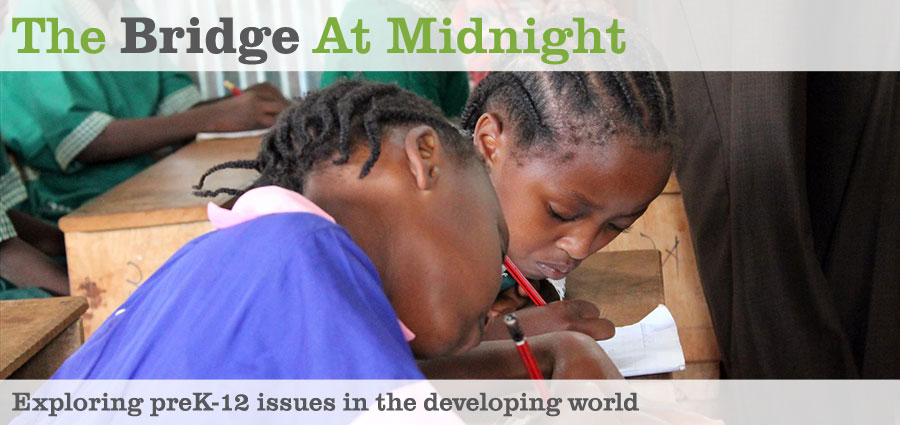Lessons From India
Posted: October 16th, 2013 | Author: Michael Goldstein | | No Comments »
Big props to a research duo that did a massive study of low-cost private schools in India. Their research methods were impeccable, sorting through all sorts of complexities.
What did they learn?
Some of it is in the eye of the beholder. The answers very a bit based in part on who is interpreting the study.
Here are 3 takes.
1. Justin Sandefur, from the Center on Global Development, writes:
7 Questions About Low-Cost Private Schools in India That We Can Finally Answer
*Do low-cost private schools improve learning?
Before the experiment started, Muralidharan and Sundararaman found that students in private schools scored dramatically better on standardized tests of math and Telugu, the local language. While we all know correlation is not causation, these gaps seemed too big to dismiss. Surely, a disparity of more than half a standard deviation couldn’t be entirely due to the sorting of advantaged kids into private schools, right?As it turns out, yes it could.
The results of the randomized evaluation should be sobering to private school cheerleaders: after two years of the originally-scheduled four-year study, voucher winners saw absolutely no relative gains in math or Telugu scores. Zero, zip, nada.
*Something tells me you’re hiding something. What else did they find?
These results were really puzzling because the private schools appeared to do better on every measure of processes that the study collected data on based on surprise school observations. The private schools had longer school days, a longer school year, lower teacher absence, higher rates of teaching activity, significantly lower pupil-teacher ratios and less multi-grade teaching .
Then a colleague suggested that maybe in addition to teaching better or worse, private schools were teaching different things. The authors examined detailed school time table data, and found that private schools were spending much less time teaching math and Telugu than public schools, and much more time on English, Hindi, Science, and Social Studies.
At the end of four years, they measured effects across all subjects and found a positive, statistically significant effect. Voucher winners scored about 0.13 standard deviations higher across all tests, and kids who actually used the voucher and went to a private school gained about 0.23 standard deviations.
The moral of the story is that while private schools are more productive than public schools, they also tend to focus on different things.
Read the whole thing here.
2. The Hindu opinion page:
Learning outcomes, as measured by performance on the Class X board exam, did not improve, however. Prof. Muralidharan said that in this context, he was less concerned about learning outcomes since the data came just two years after the program.
“In the case of secondary education for girls, I am less worried that we didn’t see a positive impact on learning in two years because the enrolment rates were so low, that getting enrolment up would be the first step followed by a focus on quality,” Prof. Muralidharan said in an email to The Hindu.
“On the other hand, I worry more about learning outcomes in primary schools because enrolment is over 95% and learning levels are flat over the past eight years, and there is no evidence that more business as usual spending is going to help much,” he said.
3. Guardian opinion page:
The study found that private schools provide better learning outcomes – at least as good in most subjects and markedly better in English and Hindi, the subjects that pay off when looking for jobs – for just a third of the cost of public school places. The vouchers also ensured the poorest and most disadvantaged kids were just as likely to enrol as children from wealthier households.
4. Authors themselves:
We present experimental evidence on the impact of a school choice program in the Indian state of Andhra Pradesh (AP) that featured a unique two-stage lottery-based allocation of school vouchers that created both a student-level and a market-level experiment. This design allows us to study both the individual and the aggregate effects of school choice (including spillovers).
We find that private-school teachers have lower levels of formal education and training than public-school teachers, and are paid much lower salaries.
On the other hand, private schools have a longer school day, a longer school year, smaller class sizes, lower teacher absence, higher teaching activity, and better school hygiene.
After two and four years of the program, we find no difference between the test scores of lottery winners and losers on math and Telugu (native language).
However, private schools spend significantly less instructional time on these subjects, and use the extra time to teach more English, Science, Social Studies, and Hindi. Averaged across all subjects, lottery winners score 0.13 (SDs) higher, and students who attend private schools score 0.23 (SDs) higher.
We find no evidence of spillovers on public-school students who do not apply for the voucher, or on students who start out in private schools to begin with, suggesting that the program had no adverse effects on these groups.
Finally, the mean cost per student in the private schools in our sample is less than a third of the cost in public schools. Our results suggest that private schools in this setting deliver (slightly) better test score gains than their public counterparts, and do so at substantially lower costs per student.


Leave a Reply